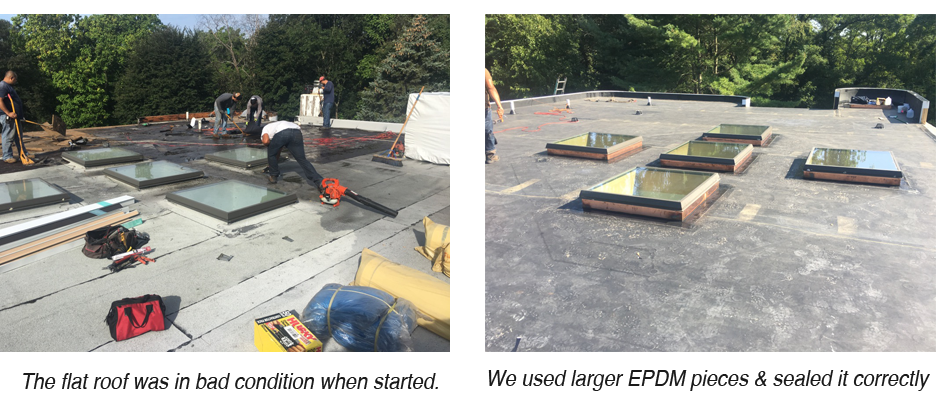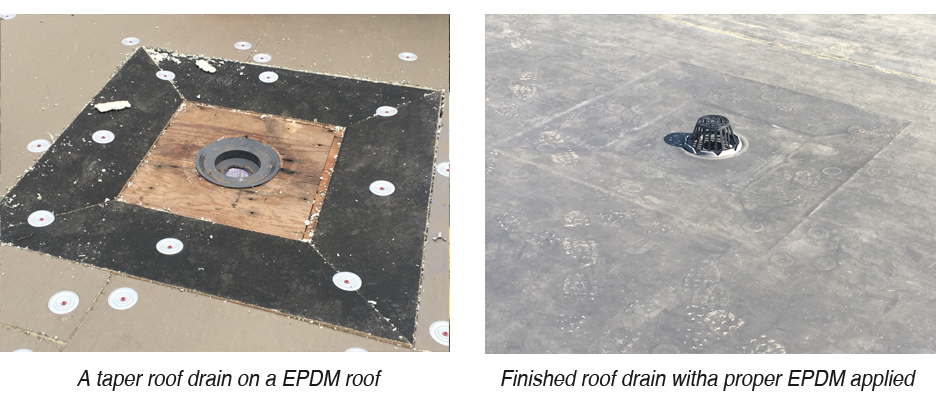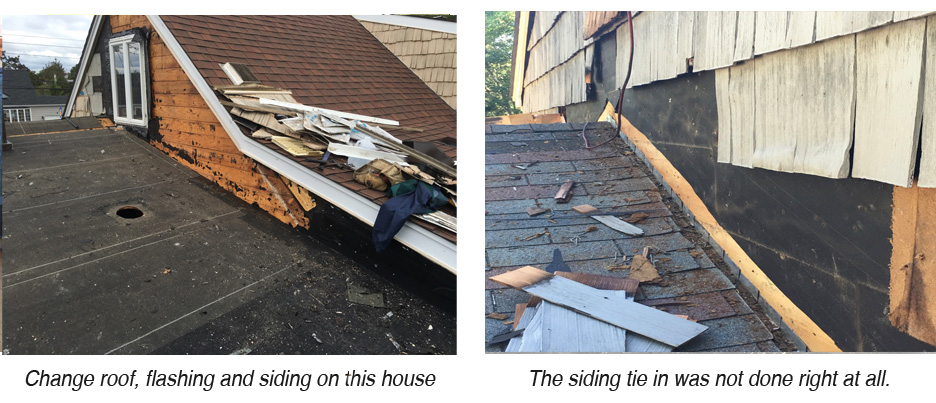22 Mar
Why do all flat roofs leak?
It seems to be a public consensus that “all flat roofs leak”. That this is just how it is, and leaks are normal and expected.
We recently replaced a torch down roof with an EPDM flat roof on a residential house in Huntington, NY. The owner had replaced the flat roof portion of the house three times by comparison to the shingle roof portion of the house. The owner was strongly considering changing the flat roof to a pitched roof. This would have been an extremely expensive project, as it had 3 skylights and 3 gutter edges. The conversion from flat roof to shingle roof would have involved an obvious reframe and sheath of the area, as well as framed tunnels for the skylights, interior and exterior finish. What was needed was a well-designed, well-executed flat roof.

With any form of roofing, pitched or flat, there are 3 primary components.
Field + Design + Flashing = Roof System
If you break them down, you will understand why flat roof systems have developed a reputation for failing.
(Field)
– This should start with understanding the building’s primary use, budget, and exposure. We have noted through the years that most roofers have their preferred system of roofing and make it fit all scenarios (One trick pony). There are many good roof systems out there, and when they end up having problems, it is usually the fault of the installation or design, not the product. When choosing the right roof material for the field, the buildings primary use needs to be established.
We recently replaced a flat roof in Hauppauge, on a building that is used for office and manufacturing. A PV solar system was to be installed upon completion of the roof. This roof is going to see a lot of action over its life, from maintenance of the HVAC systems, solar install and maintenance, and potential tenant turnover. We specified a 3 ply SA modified roof system for this building. It provided a 20-year life expectancy and is very durable, so it can handle the traffic and was reflective.
On a different project on a residential home in Commack, NY we chose a .060 EPDM rubber roof because there was much less traffic on this roof and its ability to expand and contract on a wood structure is much better than modified bitumen systems. Different buildings, different needs, different roof systems.
Using the wrong system has certainly added to the consensus that “all flat roofs leak”. The chosen system should also be installed in strict accordance with manufacturer installation guidelines, to insure the field membrane can perform as it is designed.
(Design)
– Many leaks in flat roofs can be tied directly back to design flaws in the roof itself. As good as the system and installation may be, design problems with the roof assembly can lead to its demise.
A good example of this is a customer we had in Smithtown, that had only gotten 6 years of life from an installed SBS modified roll flat roof. The execution of the installation and material were not the problem. The roof did not pitch correctly to the drain location and the drain itself was undersized for the area of roof that it needed to service. There was a sliding glass door that allowed access to this roof and it was installed less than 2” off the roof deck. The standing water, lack of draining capacity, and door height caused leaks every time there was a substantial rainfall. The standing water caused premature deterioration and seam failure to the membrane as well.

The roofing contractor who installed this roof should have made the corrections to the design of this roof prior to installing the new roof system. We put in an EPDM roof system, but we also corrected the design problems with this roof prior to the install. Two additional drains were added to upgrade the volume of water that the roof needed to handle. One of the drains was located in the area of standing water, and the sliding glass door was removed and the threshold was brought up to a full 4”. A stainless steel door pan was fabricated and installed prior to the reinstall of the door. These modifications to the design insured that the new roof could perform correctly for its entire life expectancy.
(Flashing)
– In our experience, flashing deficiencies are the primary cause of failure 9 times out of 10. The term flashing would be defined as anything that penetrates the roof or transition walls, gutter edges and perimeter edge metal systems.
A residence in Oyster Bay, which we restored this summer, had a multitude of flashing disasters to a relatively new roof system. There were 7 skylights, 8 plumbing vent pipes, 2 chimneys, and 200’ of perimeter edge metal, and all of it was leaking. This was one of the worst executions of flashing details that I have ever seen, and as the existing roofs were removed, many of the areas had significant plywood and structure damage from years of water intrusion.
Each flashing detail, whether it is a skylight, drain tie-in or parapet wall, has a very specific, best practice, industry standard method of being done. In many cases, the cost of doing all of the flashing details correctly will cost as much as the installation of the field. This is where it gets really confusing when getting estimates to repair or replace a roof. On paper, the estimates may look the same. The specified roof material is the same, but there may be large disparities in the cost from one roofer to the other. The primary reason for this is usually the method and execution of the flashings. Due to the expense, roofing contractors that are trying to compete for a job by being the least expensive, will generally move away from best practices on the flashing details in an effort to present a cheaper price.

It is critical to understand each method of flashing being proposed, so the roof that is purchased will perform correctly for its specified life expectancy. Once the right field, proper design, and detailed flashings are established, then competitive budgets can be considered. Price should not be the main indicator when choosing a roof.
In closing, the reason flat roofs have a reputation of “Always Leaking,” is that more times than not, the wrong roof system, lack of correct design, and poor flashing details were applied to the problem roof. Flat roofs can give you a long, problem-free life if done correctly.
In follow-up blogs, we will be breaking down specific flashing details and designs for each area of flat roofing in order to help understand what to look for when you need to replace your roof.


Sorry, the comment form is closed at this time.